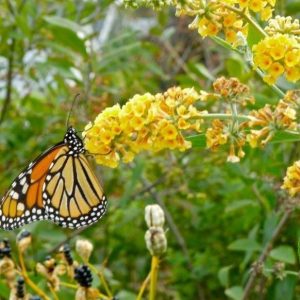Low-Maintenance and Cold Hardy Cherry Tree
The First Flowers of Spring…..and Berries!
A first cousin to the American Dogwood – the Cornelian Cherry is amazingly versatile. Left to itself, it will form a thick dense shrub that is perfect for screening and hedges. Apply just a little trimming and you have one of the most beautiful small trees around. Either way, the Cornelian Cherry will provide a year-round show of beauty!
It will be one of the first plants to bloom in the spring; branches covered with clusters of fuzzy yellow star-like flowers. This show is followed by dark shiny green leaves and then accented by the beautiful bright red olive-like berries which ripen in the late summer.
In the fall, your Cornelian Cherry provides a jazzy mahogany red display, as the leaves begin to turn and. Just when you think the show is over – Your Cornelian Cherry comes back with an encore, as its bark begins to exfoliate and curl, revealing shades from gray to brown, in a visually pleasing display of texture and color. The Cornelian Cherry is truly the master of multi-seasonal beauty.
Draw in Wildlife, and Enjoy the Show!
If you are a lover of wildlife and nature, your Cornelian Cherry will provide you with a never-ending show, as the birds and other wildlife are drawn to the tantalizing ruby-red berries that hang in clusters from its branches. The berries are edible and full of nutrients. Although a little on the tart side – the Cornelian Cherries (or Cornels) are perfect for making preserves, syrups and other delightful treats.
Plant your Cornelian Cherry in any exposure, from full sun to full shade; It will adapt. Space the plants 20 to 25 feet apart and ideally plant two or more for proper pollination. As the tree matures, it will reach a height of 15 to 30 feet, with a spread of up to 20 feet across. In its native habitat, the Cornelian Cherry lives upwards of 150 years; how’s that for hardy?
The Cornelian Cherry is a Unique and Delightful Addition to any Landscape.
Planting & Care
Cornelian Cherry Dogwood (Cornus Mas) is known for it’s early bloom in spring with clusters of fuzzy yellow, star-like flowers. It produces edible fruit in summer and a red foliage color in fall. This dogwood is known to be quite cold hardy and can be grown into a small tree or large shrub that prefers full sun. The Cornelians perform their best in USDA growing zones 4-9 and are considered to be slow growers maturing to a height of 15-30 feet with a width of 15-20 feet.
Location: When planting Cherokee Chief Dogwood tree, find a site that offers full sun to partial shade. This tree can handle a variety of different soil types including clay.
Planting Instructions: Select a site that is well-draining for your Cornelian Cherry Dogwood.
1) Dig your hole three times the width of the root ball and slightly shallower than the root ball.
2) Loosen the soil, in and around the hole so the roots can easily break through.
3) Use your fingers to separate the roots of your Cornelian Cherry Dogwood and gently position downward in the hole. Hold the tree straight as you begin to backfill the site tamping down the soil as you go.
4) Apply water to settle the soil and remove any air pockets that may have formed and mulch to conserve soil moisture.
Mulching: Protect the roots in the cold of winter by applying a thick layer of pine needles, bark or wood mulch. To avoid fungus and rot, keep the mulch about 2 inches from the trunk. Mulching will also help with keeping the soil moist as well as deter weeds and grasses from growing.
Watering: The dogwood tree will need regular watering when it doesn’t rain. Be sure to give it a good deep watering when you first plant it to help it settle in and then water it regularly after it’s planted depending on your climate and natural precipitation. If you have no rainfall, it will likely need a good soaking to get the water down to the ends of the roots (at least 12 inches).
Fertilizing: You can fertilize young shrub to increase both the size and the amount of flowers on the plant. Liquid, Granular or stake type can be used. The best time to fertilize is in spring after your last frost. Fertilize again 6 weeks after to encourage more flowers and faster growth.
Pruning: Cornelian Cherry Dogwood will need little pruning that can be very important to the overall look of the plant. Be sure to only prune in Spring before flowers and leaves emerge. Remove crossing, dead or injured branches.









